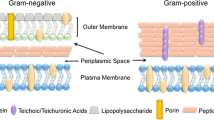Abstract
A new class of photosensitizers which inactivate efficiently Gram-positive bacterial cells is described. The photosensitizers used in this study were Mg and Zn-tetrabenzoporphyrin (MgTBP and ZnTBP), which possess strong absorption bands at 630 nm and Cd-texaphyrin (CdTX), whose longest absorption band is at 770 nm. These sensitizers thus have optical properties that are superior to those of haematoporphyrin. It is demonstrated that MgTBP and CdTX have similar photosensitizing efficiencies as haematoporphyrin on Gram-positiveStaphylococcus aureus cells but are better on the Gram-negativeEscherichia coli in the presence of polymyxin nonapeptide, a membrane permeabilizing material. It seems, from the elemental content of the photosensitized Gram-positive and Gram-negative bacterial cells, that there is a difference in the killing mechanism of haematoporphyrin as compared to that of MgTBP or CdTX.
Similar content being viewed by others
References
Dougherty TJ, Kaufman JE, Goldfarb A et al. Photoradiation therapy for the treatment of malignant tumors.Cancer Res 1978,38:2628–35
Kessel D. Hematoporphyrin and HPD: photophysics, photochemistry and phototherapy.Photochem Photobiol 1984,39:851–9
Moan J, Berg, K. Photochemotherapy of cancer-experimental research.Photochem Photobiol 1992,55:931–48
Henderson BW, Dougherty TJ. How does photodynamic therapy work.Photochem Photobiol 1992,55:145–57
Gomer CJ, Doiron DR, Rucker N et al. Action spectrum (620–640 nm) for Hpd induced cell killing.Photochem Photobiol 1984,39:365–8
Moan J, Sommer S. Action spectra for Hpd and Photofrin II with respect to sensitization of human cells in vitro to photoinactivation.Photochem Photobiol 1984,40:631–4
Gomer CJ. What makes a good photosensitizer for photodynamic therapy?J. Photochem Photobiol [B] 1988,1:376–8
Kreimer-Birnbaum M. Modified porphyrins, chlorins, phthalocyanines and purpurins: second-generation photosensitizers for photodynamic therapy.Semin Hematol 1989,26:157–73
Moan J. Properties for optimal PDT sensitizers.J Photochem Photobiol [B] 1990,5:521–4
Jori G. Far-red-absorbing photosensitizers: their use in the photo-dynamic therapy of tumors.J Photochem Photobiol [A] 1992,62:371–8
Ehrenberg B, Johnson FM. Spectroscopic studies of tetrabenzoporphyrins: MgTBP, ZnTBP and H2TBP.Spectrochim Acta, Part A 1990,46:1521–32
Gross E, Ehrenberg B, Johnson FM. Singlet oxygen generation by porphyrins and the kinetics of 9, 10 dimethylanthracene photosensitization in liposomes.Photochem Photobiol 1993,57:808–13
Harriman A, Maiya BG, Murai T et al. Metallotexaphyrins: a new family of photosensitizers for efficient generation of singlet oxygen.J Chem Soc Chem Commun 1989:314–16
Barrett RP, Linstead RP, Rundall FG, Tuey GAD. Phtalocyanines and related compounds. XIX. Tetrabenzoporphyrin, tetrabenzmonazaporphyrin and their metallic derivatives.J Chem Soc 1940:1079–92
Linstead P.: Discoveries among conjugated macrocyclic compounds.J Chem Soc 1953:2873–84
Vaara M, Vaara T. Polycations sensitize enteric bacteria to antibiotics.Antimicrob Agents Chemother 1983,24:107–13
Warley A, Ward JPT, Chopra LC. Element concentrations in rabbit bronchial smooth muscle in culture measured using X-ray microanalysis.J Physiol 1991,551:61–6
Ehrenberg B, Malik Z, Nitzan Y. Fluorescent spectral changes of hematoporphyrin derivative upon binding to lipid vesicles.S. aureus andE. coli cells.Photochem Photobiol 1985,41:429–35
Malik Z, Ladan H, Ehrenberg B, Nitzan Y. Bacterial and viral photodynamic inactivation. In: Henderson B, Dougherty TJ (eds)Photodynamic Therapy: Basic Principles and Clinical Applications. New York: Marcel Dekker, 1991: Chap 8, 97–113
Bashford CL, Smith JC. The determination of oxonolmembrane binding parameters by spectroscopic methods.Biophys J 1979,25:81–5
Ehrenberg B. Assessment of the partitioning of probes to membranes by spectroscopic titration.J Photochem Photobiol [B] 1992,14:383–6
Nitzan Y, Gutterman M, Malik Z, Ehrenberg B. Inactivation of Gram-negative bacteria by photosensitizing deuteroporphyrin.Photochem Photobiol 1992,55:89–96
Ehrenberg B, Lavi A, Nitzan Y et al. Spectroscopy, photokinetics and cellular effect of far-red and near infrared absorbing photosensitizers. In: Dougherty TJ (ed)Optical Methods for Tumor Treatment and Detection, Vol 1645, Bellingham, WA: SPIE, 1992:259–63
Rosenthal I, Ben-Hur E, Greenberg S et al. The effect of substituents on phthalocyanine photocytotoxicity.Photochem 1987,46:959–63
Judy MM, Matthews JL, Newman JT et al. In vitro photodynamic inactivation ofherpes simplex virus with sapphyrins: 22 π-electron porphyrin-like macrocycles.Photochem Photobiol 1991,53:101–7
Malik Z, Gozhansky S, Nitzan Y. Effects of photoactivated hematoporphyrin derivative on bacteria and antibiotic resistance.Microbios Lett 1982,21:103–12
Nitzan Y, Gozhansky S, Malik Z. Effect of photoactivated hematoporphyrin derivative on the viability ofStaphylococcus aureus.Curr Microbiol 1983,8:279–84
Nitzan Y, Shainberg B, Malik Z.. Photodynamic effects of deuteroporphyrin on Gram positive bacteria.Curr Microbiol 1987,15:251–8
Bertoloni G, Salvato B, Dall'Acqua M et al. Hematoporphyrin-sensitized photoinactivation ofStreptococcus faecalis.Photochem Photobiol 1984,39:811–6
Venezio FR, DiVincenzo C, Sherman R et al. Bactericidal effects of photoradiation therapy with hematoporphyrin derivative.J Infec Dis 1985,151:166–9
Malik Z, Babushkin T, Ladan H et al. Cell-death induced by discrete processes: its reflection in cellular ion content revealed by X-ray microanalysis.Micron Microsc Acta 1992,23:369–70
Author information
Authors and Affiliations
Rights and permissions
About this article
Cite this article
Ehrenberg, B., Malik, Z., Nitzan, Y. et al. The binding and photosensitization effects of tetrabenzoporphyrins and texaphyrin in bacterial cells. Laser Med Sci 8, 197–203 (1993). https://doi.org/10.1007/BF02547876
Received:
Issue Date:
DOI: https://doi.org/10.1007/BF02547876




